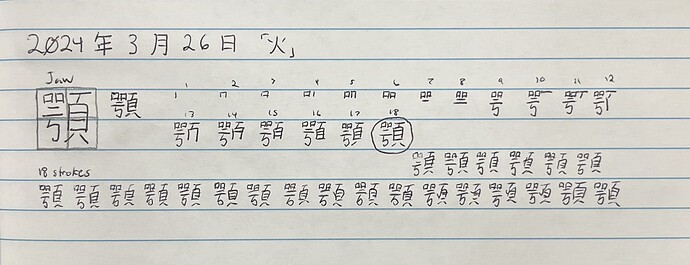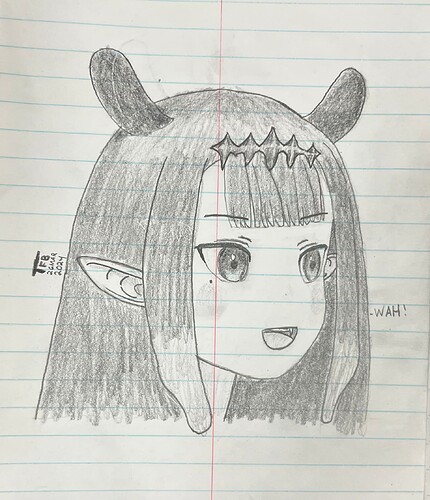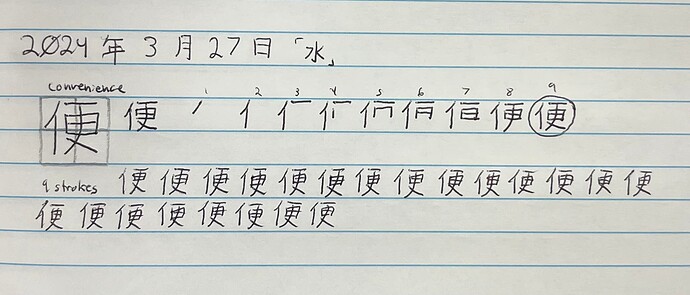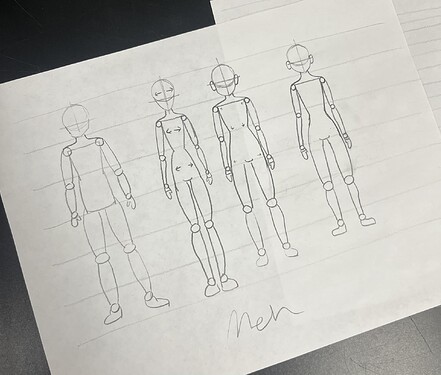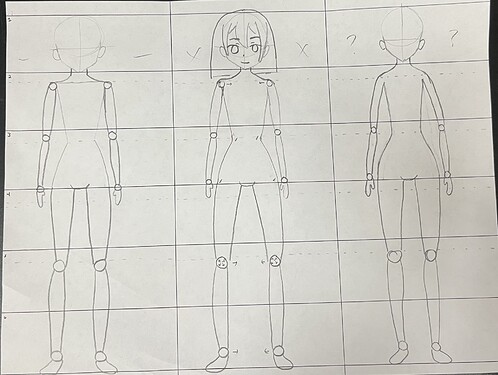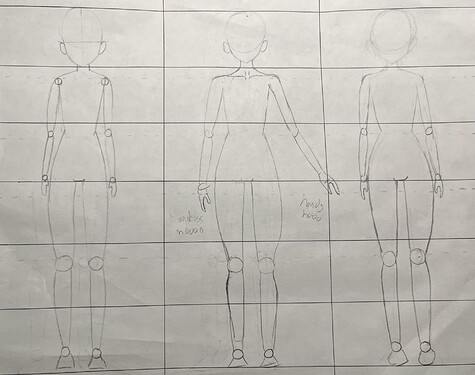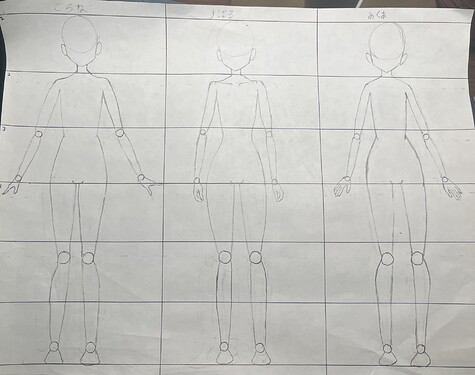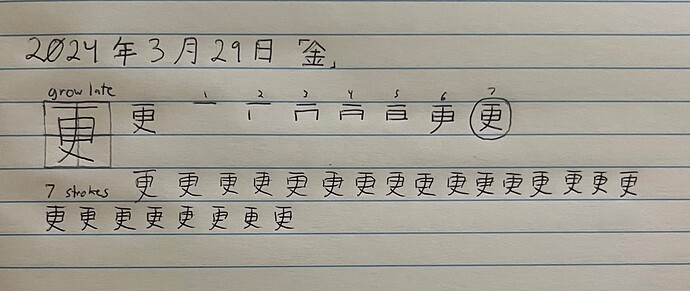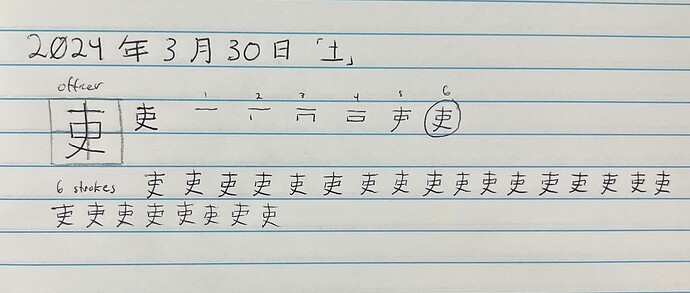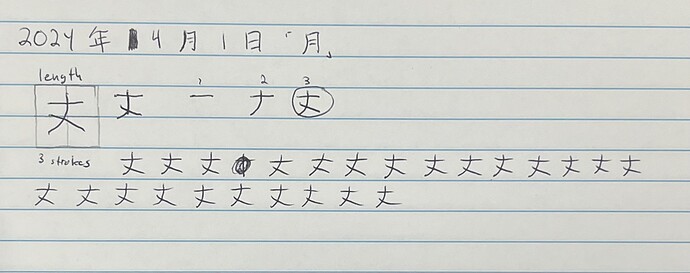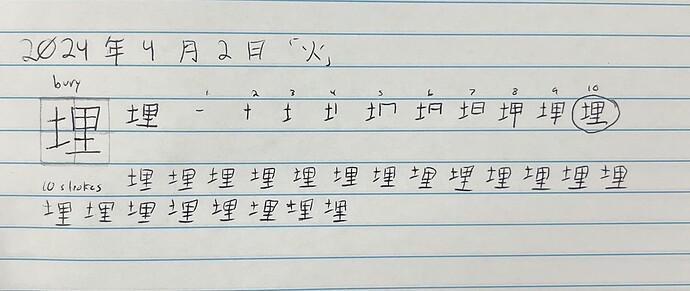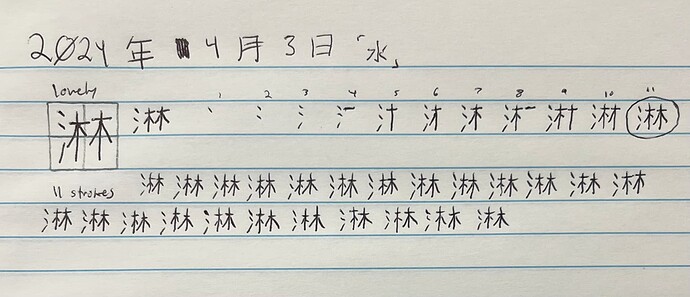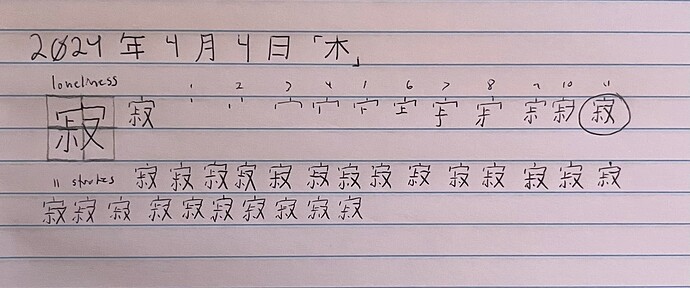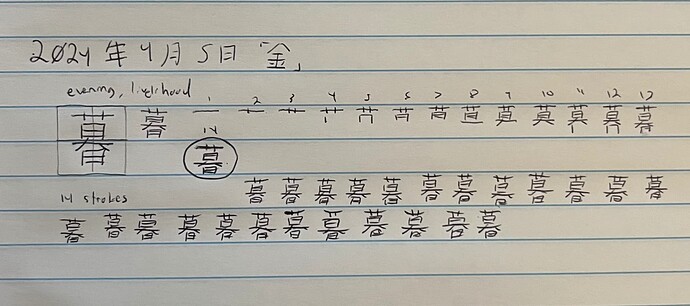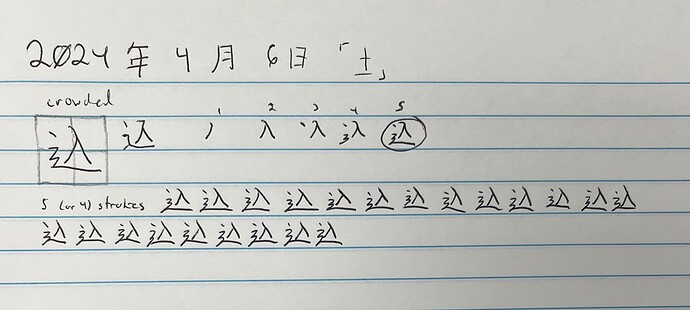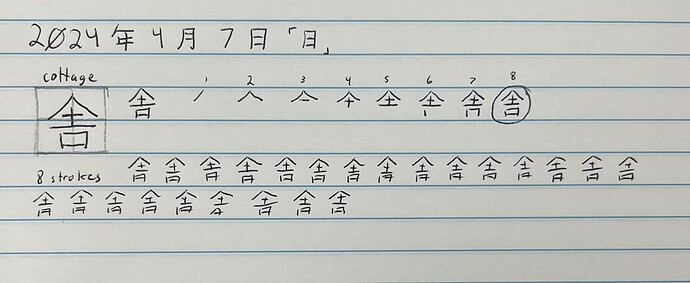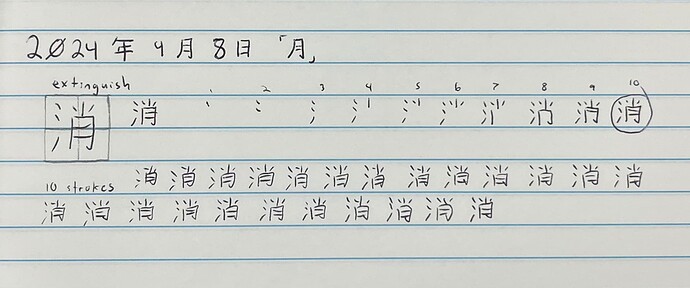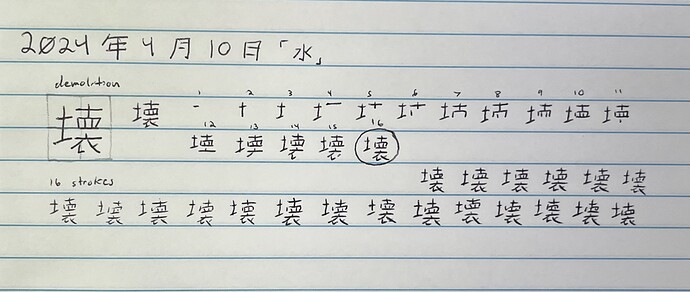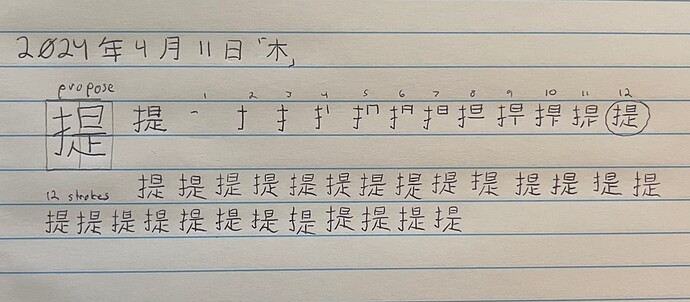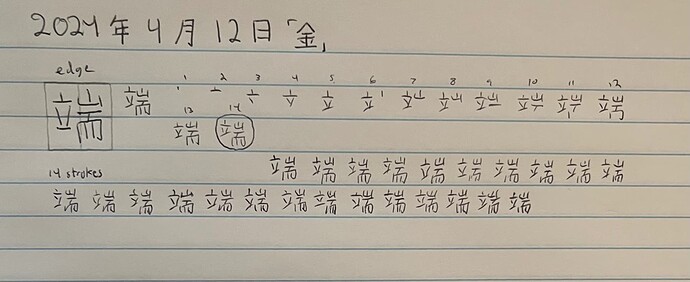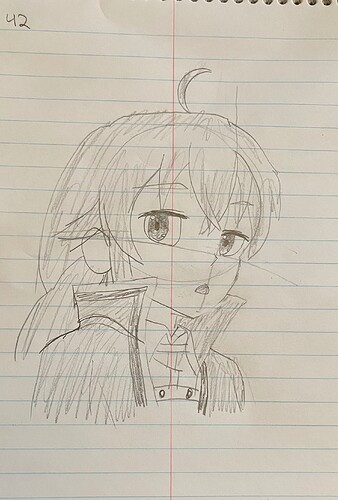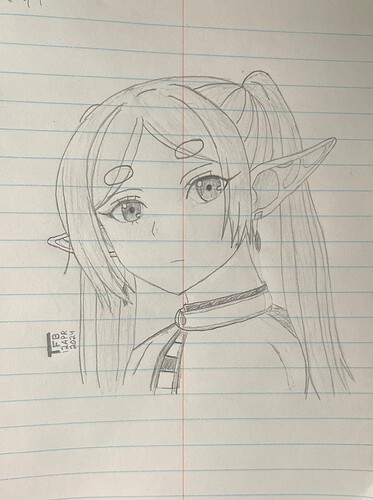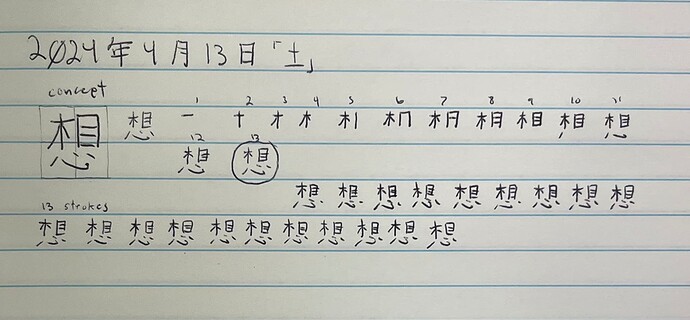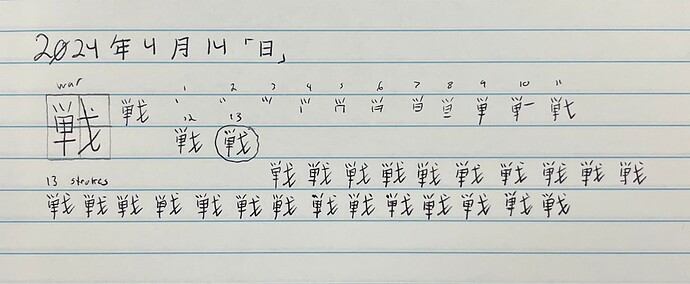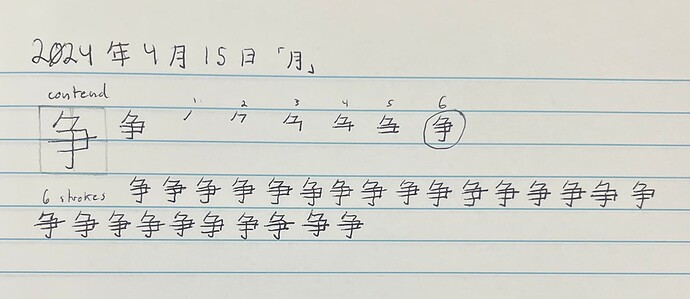Your art has come a long way in such a short time! I hope you’ve seen as big an improvement with your kanji as well.
2024年3月26日「火」
メモ:Another Body-Related Kanji I missed. I really thought that with 顔 and 頭 that I was done with the head, but clearly I was wrong.
Thank you so much! I kept telling myself that I was fine not doing art, or that I was too busy to start trying, or I was too old and it was too late to get better, but I finally picked up a pencil and got to it.
For my Kanji journey, this experiment has been hugely successful. Not only has it helped improve my overall vocabulary, but I’m much better at recognizing Kanji, especially after I’ve written it down, and I’m a lot better at guessing a Kanji’s stroke order just by looking at it. There’s obviously times where I’m wrong, but I’ve certainly improved. As for my handwriting, I’ll let you all be the judge of that…
biboo!! pebbles unite! 
2024年3月27日「水」
メモ:Not to be confused with 使、and chosen today to help with that exact comparison. I wonder what tomorrow’s Kanji will be~~~
2024年3月28日「木」
漢字:使
訓読み:つか.う、つか.い、‐づか.い
音読み:シ
メモ:Who could’ve guessed?
A very important Kanji to use. Not super complex, but important to differentiate between 便 and 使.
Daily Art Practice
On to full body figures! Below are my first two days of working on it, eventually I’ll be working on clothing and advanced body structures 
First four ^
Last of day one ^
Day two’s figures ^
Learning proper proportions is really tough, and getting the curves right for all the limbs is still something I’m working on, but I think they’re starting to turn out decent. Next is more posing, and then filling in additional body structures, hands, and clothing.
2024年3月29日「金」
メモ:Minus another stroke, and we get 更、similar to 便 but minus the modified 人 radical.
Common uses are the words 「更に」、 or “Furthermore”, 「更ける」、 or “To get late”, and many Kanji Compound words, like one of the words I learned today, 「変更」、 or “Change/Modification”.
Judging by this pattern, tomorrow’s kanji should be…
2024年3月30日「土」
Similar to 更 and 使、but one stroke less than the former, and missing a modified 人 radical from the latter. This one doesn’t seem so common in comparison to the previous three, but does seem to be considered an N1 Kanji.
2024年3月31日「日」
2024年4月1日「月」
メモ:Same general shape, but less and less strokes. Sort-of “breaking down” Kanji like this has been kind of fun. Going through each one helps me better understand the Kanji I already know, and exposes me to a lot of “Look-a-like” characters to watch out for.
2024年4月2日「火」
漢字:埋
訓読み:う.める、う.まる、うず.める、い.ける
音読み:マイ
メモ:埋まればいいじゃん、埋まればいいじゃん 「18歳+だけ」
Word was suggested by a colleague of mine and decided to write it out. Helps that I recently learned the word too, so this should help me remember it a bit better.
2024年4月3日「水」
メモ:「淋しくなったら誰でもいいじゃん…」
I keep forgetting it’s April now. I keep wanting to write 3月… Oh well.
Goes along with yesterday’s Kanji. For context, follow the link on the previous post. If you end up with an earworm, I take no responsibility 
2024年4月4日「木」
漢字:寂
訓読み:さび.しい、さび.れる、さみ.しい
音読み:ジャク、セキ
メモ:If you’re on EST, I still have an hour or so to post this.
I don’t know if there is any functional difference between 寂しい and 淋しい、 but if anyone reading does know, I would love to know as well!
2024年4月5日「金」
メモ:No particular reason for this one today. It just showed up in my deck and I had forgotten it from the last time I learned it, so I figured writing it here would help me remember it moving forward.
2024年4月6日「土」
2024年4月7日「日」
メモ:Forgot to post yesterday’s, so here’s Two.
I’ve always been bad at writing out Kanji containing the ⻌ radical, so it felt good to work on it a little bit.
I also got confused by the word 「田舎」recently so I looked into it, only to realize the reading is completely different than the Kanji attached. It looks like the word 「でんしゃ」 has been made obsolete by 「いなか」、so just another exception to remember.
2024年4月8日「月」
2024年4月9日「火」
メモ:Both of these are coming from my flashcards again.
It’s interesting how 「謎」is almost written backwards in comparison to other Kanji. Instead of starting with the middle, then going left and right, you start with the left and right, and then finish with the middle radical. In reality, it’s just following the standard stroke order of writing out whatever is on top of 「⻍」first, and then writing it out underneath.
2024年4月9日「水」
2024年4月10日「木」
2024年4月11日「金」
漢字:端
訓読み:はし、は、はた、-ばた、はな
音読み:タン
メモ:More flashcards. I’ve been falling a bit behind on going back over my old kanji, so I’ll have to try and make more of an effort to work on that.
Are you talking about 米 here? That’s just the normal stroke order for 米 itself. It’s the same when used in 数 or 類, for example. Perhaps I’ve misunderstood you though?
I’m talking about the whole Kanji. Instead of starting with the middle, 「⻍」、you start with 「言」、then 「米」、and finally 「⻍」、starting with the left half, skipping the middle to go to the right half, and then finishing the kanji in the middle. This is opposite of the stroke order of say, the top part of 「鬱」、where you start in the middle, then write out first the left 「木」、then the right 「木」。
Just a silly thought 
Ah I get what you mean now. I didn’t register what you meant because I see the kanji has having two halves (言 and 迷) so didn’t really understand what you meant by the middle. Kinda interesting how different people end up seeing kanji differently.
2024年4月13日「土」
メモ:I see this kanji a lot, and while I don’t find it particularly difficult, I figured it would be good to go over individually.
2024年4月14日「日」
漢字:戦
訓読み:いくさ、たたか.う、おのの.く、そよ.ぐ、わなな.く
音読み:セン
2024年4月15日「月」
メモ:Didn’t end up writing out a Kanji yesterday, so here’s two.
I learned 「戦争」a while ago in my flash cards, but when reading a web novel, I came across it again and didn’t recognize it at all. It didn’t even dawn on me that I had learned this word before, so I figured I should really go back over it to ensure I at least recognize it in the future.

